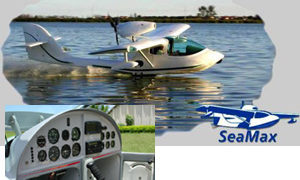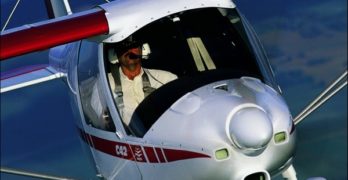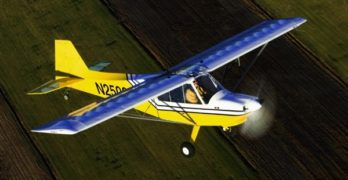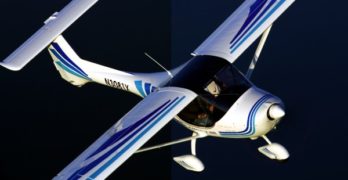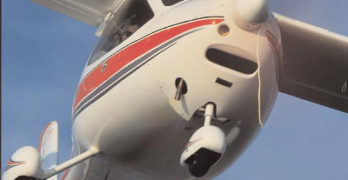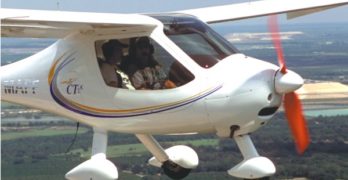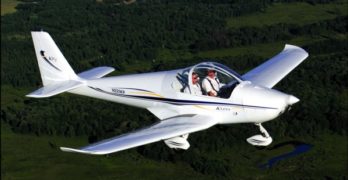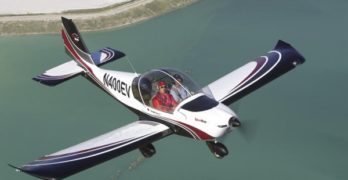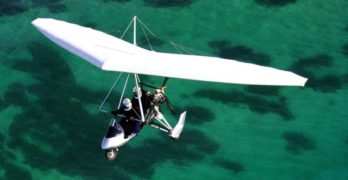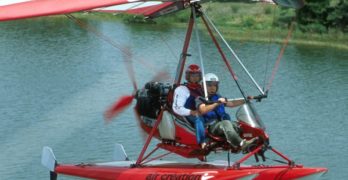My old friend Malcolm Jones* and Carlos Bessa will unveil a lovely amphibian LSA called SeaMax at the Sebring LSA Expo starting tomorrow. SeaMax by Brazilian producer AirMax intends to achieve Special Light-Sport Aircraft status but it has been cutting through waves in other countries for several years. SeaMax is a lighter amphibian, with gross weight at 1,144 pounds (a max of 1,430 is allowed). At 660 pounds empty, the composite seaplane yields a 484 pound useful load and can carry up to 25 gallons of fuel. SeaMax can lift off the water in only 325 feet. Electrically operated landing gear can be lowered into the water for taxiing onto a beach. SeaMax has a broad 46-inch wide cockpit and lots of attention to detail has been paid to the speedboat-like interior finish. * Malcolm operates a favorite hang gliding airpark called Wallaby Ranch just eight miles south of Disney Florida.
Search Results for : Rotax electric
Not finding exactly what you expected? Try our advanced search option.
Select a manufacturer to go straight to all our content about that manufacturer.
Select an aircraft model to go straight to all our content about that model.
C42…An Ideal Light-Sport Aircraft Trainer?
Germany’s most popular microlight flies to America
Some readers and enthusiasts are excited about the proposed sport pilot/light-sport aircraft rule, while others have taken a wait-and-see approach. Virtually all recreational pilots are full of anticipation and questions. In the meantime, aircraft developers are also preparing.
Of those aircraft likely to become new ready-to-fly light-sport aircraft (LSA), many hail from Europe because its microlight regulations are close to the expected definition of LSAs in the United States. Germany is home to many manufacturers that produce potential LSAs, including Comco Ikarus, makers of the C42 Ikarus. The company has produced more than 1,500 aircraft, of which more than 650 are the C42 model. It’s an aircraft that both general aviation and microlight pilots appreciate, noted by the fact that it is Germany’s best-selling microlight. Every year, the factory cranks out another 80 C42s.
The design was first produced in 1996. Rather than follow the design of the company’s older C22, which looks like a Flightstar II SL in its Fastback version, the C42 started fresh.
Proven again: Rans’ newly approved S-7LS
You’ve probably heard the tongue-in-cheek expression, “No good deed goes unpunished.”
RANS President Randy Schiitter knows this saying in a way no other light-sport aircraft
(LSA) producer can. When the company’s S-7 Courier earned special light-sport aircraft
(S-LSA) approval on October 24, 2005, it was the second time this aircraft
was certificated as a ready-to-fly (RTF) airplane, after first being designed as a kit.
RANS earned Primary Category certification
for this aircraft, as the S-7C
model, 10 years ago when that FAA regulation
was the latest big thing in aviation.
It took the Kansas company years
to complete that certification process,
but the recreational pilot certificate and
Primary Category certification failed
to meet industry expectations. After
spending lots of time and money earning
that approval, RANS didn’t jump
on the LSA bandwagon immediately.
The S-7 Courier was the first twoseat
aircraft produced by RANS, dating
to 1985 when the first prototype flew.
A Winner Among LSA (Allegro)
The Allegro is the value leader among LSA designs.
One year ago, the fi rst special light-sport aircraft
(S-LSA) were approved and delivery of S-LSA began.
A few brands stand above the rest in the number of
aircraft delivered. One of those is the Allegro 2000, imported into
the United States from the Czech Republic by Fantasy Air USA. Since May 19, 2005,
when the Allegro earned S-LSA approval, Fantasy Air has delivered more than 40 aircraft,
keeping owners Doug and Betty Hempstead busy.
One of the appealing factors of the Allegro 2000 is its price, which starts in the upper
$50,000 range for the flyaway version. An airplane with an attractive price has a clear
advantage over others with higher price tags. When that airplane flies well, is supported
well, and has the equipment desired by consumers, it’s likely to succeed.
Well-Established
Given its fast start, Fantasy Air USA
has reason for optimism, but the
Allegro design has a much longer
history outside this country.
Flight Design CT2K
A Bold Yet Efficient Euro-Designed Light-Sport Aircraft
Flightstar imports the CT2K in anticipation of the light-sport aircraft rule.
As FAA’s proposed light-sport aircraft
rule looms ever closer, one
of the first aircraft that will likely
fit the field and be recognized by American
pilots is Germany’s CT. For the U.S.
market, and with a nod to the new millennium,
producer Flight Designs has
renamed the model as the CT2K.
“CT” stands for Composite Twoseater.
It is certainly not alone in being
“white, glass, and built overseas,” a
theme that emerged at EAA AirVenture
Oshkosh 2002. But the design was a
leader in the move from tube-and-rag
ultralights to the modern microlights of
Europe. And it distinguishes itself in a
number of ways that we’ll explore in
this review.
My experiences flying the CT on two
occasions were both with Europeanbased
check pilots. The most recent
opportunity was with Allistair Wilson,
formerly a major with the Royal Irish
Regiment in Northern Ireland.
Composite Two-seater (CT)
In the fall of ’01, I wrote in Ultralight Flying!, “The CT is the tip of an iceberg, in my opinion.” When I flew that first CT in the USA, few Yankees had seen the aircraft. I felt the German design represented the beginning of a flow of European aircraft coming to America. What a difference a couple of years make!
Thanks to adept and steady promotion, Americans may best identify the coming breed of proposed Light-Sport Aircraft by pointing to the Flight Design CT2K. While this means no disrespect to trikes, tube-and-rag ultralights, or powered parachutes, the CT’s unusual, smoothly-contoured shape is now well known to many Americans. Though the brand is fabricated in the Ukraine and assembled in Germany, it crosses the Atlantic as a prototypical candidate for FAA’s proposed Light-Sport Aircraft category.
Rollison Light Sport Aircraft imported the first U.S.-based CT I flew. The design is now brought in by Flightstar Sportplanes and HPower HKS engine honcho Tom Peghiny.
Kappa KP-5 An All metal Beauty
Kappa’s KP-5 … a great trainer and more!
At EAA AirVenture Oshkosh
2005, 13 aircraft on
display in the Light-Sport
Aircraft (LSA) Mall-
which put LSA on center
stage just south of AeroShell Square-
had their airworthiness certificates as
special light-sport aircraft (S-LSA). (A
14th aircraft, the Savage Cub, exhibited
in the North Commercial Area,
also earned its S-LSA certificate, but
only had one aircraft to display.) That
14 aircraft earned S-LSA certificates
in the short span of three and a half
months since the FAA announced
the availability of the final consensus
standards for LSA-category airplanes
is an unprecedented accomplishment.
No one can recall when so many airplanes
have been certificated in such
a short time.
One of those baker’s dozen plus
one is the Jihlavan (pronounced
“YEE-la-von”) KP-5, better known to
Americans by its importer’s name-
Kappa Aircraft KP-5. It is an elegantly
styled, all-metal LSA with a high-visibility
cockpit, a high-performance
wing with well-regarded Fowler
flaps, tough trailing link landing
gear, and the popular Rotax 912
powerplant.
A Sporty SportsStar: Leading the LSA Parade
Being first is often good in marketing, sports, or life in general, for that matter. In the light-sport aircraft (LSA) certification race, one aircraft has already won: the Czech Republic-built Evektor SportStar. This all-metal, low-wing, bubble-canopy design was the first aircraft to win its airworthiness certificate as a special LSA (S-LSA), and no one can ever take that distinction away.
Evektor Aerotechnik appointed Sport Aircraft International of Kerrville, Texas, as its American distributor. That company is currently in the process of transitioning to Evektor America as its new trade name. At EAA AirVenture Oshkosh 2005, it exhibited a beautifully finished SportStar SE alongside Evektor’s four-seat Cobra, which is aimed at the Cirrus market. In the LSA Mall, another SportStar presented itself to thousands of visitors.
I flew the first imported version of the SportStar, then called the EuroStar, a few years ago. The day after EAA AirVenture 2005 ended, I was delighted to join Evektor America President Jeff Conrad and rocket down Wittman Field’s runway in the newest SportStar SE (special edition).
AirBorne’s XT 912 Trike
Racing to be the first weight-shift S-LSA
In early January, the FAA accepted the ASTM consensus standards
for weight-shift control (WSC) aircraft, commonly known as trikes.
The agency’s action paved the way for trike manufacturers to certificate
ready-to-fly machines as special light-sport aircraft (S-LSA). Now,
the race is on to see which company will be the first to complete the
steps necessary to show compliance with the newly approved standards.
One company in the running is
AirBorne Australia, and it is already
accepting orders for its S-LSA model,
the AirBorne XT 912. How can it be so
confident this model will comply? Its
machines already meet Australia’s tough
certification standards, so the effort is
primarily one of paperwork. (Though
preparing documents to the FAA’s precise
requirements is no trivial task, as
anyone who has tried to correctly fill
out the sport pilot certificate application
knows.) Interestingly, Australia is
one of two nations-Colombia is the
other-that have accepted the sport
pilot/light-sport aircraft (SP/LSA) rule
as part of their national program.
Air Création’s High-Performance Floats
Air Création is a serious company and a world-class trike builder with an impressive sales record. Their serious trikes sport beautiful hardware and numerous customized components. Right down to their trademark red color, Air Création is serious about building a remarkable trike, a series of them in fact.
So when Air Création puts a float set on the market, you can count on the fact that it was well researched and exquisitely crafted.
Now, let’s combine that with the XP-17 wing, the largest in the company’s XP series. Floats are mounted under and the wing atop a GTE trike carriage which has been in production for several years. Put this all on a lake in Florida and you have the makings of an interesting experience.
Another 20-Year Veteran
Gilles Bru and Jean Yves le Bihan founded the French company in 1982. Air Création’s dealer in Canada reports, “It has grown steadily ever since, building around 4,000 wings and 2,500 trike-units for sale in more than 50 countries.”
Today Air Créationemploys 25 people, four of whom are in the technical department designing new products, and 14 work on the production of ultralight trikes and wings.With annual sales of about $2.5 million, Air Création exports 60% of its products.
- « Previous Page
- 1
- …
- 23
- 24
- 25
- 26
- 27
- …
- 36
- Next Page »


